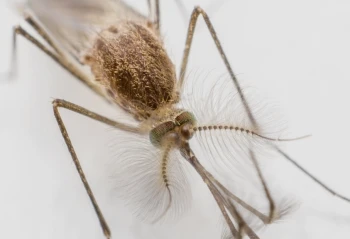West Nile virus
How can we protect ourselves from a virus that spreads as the crow flies?
The West Nile virus is a relatively unknown virus should not be underestimated. Especially because it is spread by our own European mosquitoes and birds.
The spread of the West Nile virus
The West Nile virus was first discovered in 1937, in the West Nile district in Uganda. It took until the 1990s, however, to find its way to Europe and the Americas.
Birds are the main carriers of the West Nile virus, especially blackbirds and jackdaws. Their blood can contain high concentrations of the virus. Mosquitoes that feed on infected birds pass it on, not only to other birds, but also to humans and horses.

West Nile fever
Most people are unaware of their West Nile virus infection. Only one in five infected people will develop flu-like symptoms, also known as the West Nile fever. One per cent of the patients who contract West Nile virus suffer from serious complications, such as inflammation of the brain. For people with an impaired immune system, the virus can even be fatal.
Vaccines
A vaccine is the most effective way to prevent infectious diseases. A vaccine teaches the immune system to recognise and eradicate the virus when it comes across it in real life. There are various West Nile virus vaccines available for horses, but these are not approved for human use. West Nile virus vaccines are under development.
BPRC research
BPRC is also involved in this process. Experimental vaccine candidates that meet all the known requirements can be evaluated in monkeys.
For this, BPRC developed two in vivo models. Both rhesus monkeys and marmosets are susceptible to the West Nile virus infection and have an immune system that is similar to that of humans. In addition, experimental infection studies showed that the West Nile virus infection in monkeys strongly resembles the infection in humans. As a result, our West Nile virus infection models are good models to evaluate new experimental West Nile virus vaccines.
During a typical vaccine study, the animals are vaccinated at regular intervals. Two weeks after each immunisation, we take a blood sample and examine this in the laboratory. The presence of West Nile virus-specific antibodies is a first indicator that the vaccine may work. In order to assess if the vaccine actually protects from experimental infection, we expose animals to the virus under controlled and reproducible circumstances, such as a fixed number of infectious particles.
Rhesus monkeys and marmosets do not show clinical symptoms after West Nile virus infection, so West Nile virus concentration is measured in blood samples taken at regular intervals.
Just like any other scientific experiment, an animal study requires proper controls. Since a virus consists of genetic material surrounded by a protein shell, it cannot exist on its own. Although a virus is not a living being, it can die. In order to prevent drawing false conclusions from an animal study – for example based on dead virus instead of live virus – we include 'control animals' in each study. These animals are not vaccinated before being exposed to the virus.
The efficacy of an experimental vaccine is determined by comparing the viral load in vaccinated animals and control animals. The results of these ‘proof of principle’ studies largely determine if a vaccine candidate will be further developed for human use, or not.
The 3Rs in West Nile virus research
Anyone who works with laboratory animals in Europe is required to explain why their research cannot be performed in any other way. Can it be done without using laboratory animals? Or can it be done using fewer animals? Which techniques are available to minimise the discomfort for the laboratory animals? In other words: have the 3Rs been implemented?
Replacement
A vaccine is designed to activate an immunological memory. To evaluate an experimental vaccine, a fully functional immune system is required. In the case of the West Nile virus, we currently do not know how this memory is generated and what mechanisms in the immune system are responsible. As such, there is currently no animal-free method to study the interaction between a West Nile virus vaccine and the immune system.
Reduction
Only the most promising vaccine candidates are evaluated in animals. Numerous animal-free techniques are used to prevent ineffective or less-effective vaccines from being tested in animals. Combining several vaccine candidates in one study also reduces the number of animals needed.
Refinement
The Netherlands National Committee for the protection of animals used for scientific purposes uses the following definition for the refinement of animal testing: the refinement of animal testing aims to reduce the discomfort of laboratory animals and/or to optimise laboratory animal welfare.
Good living conditions are a key part of our animal welfare policy. At BPRC, animals are always housed in social groups and never alone, and we have an extensive environmental enrichment programme. Furthermore, the animals are trained to reduce stress during experiments.
The rise of HIV and the unprecedented progress in biomedical science go hand in hand, both in terms of technology and animal welfare. As a result, much more data can be collected per animal and their discomfort is minimised.